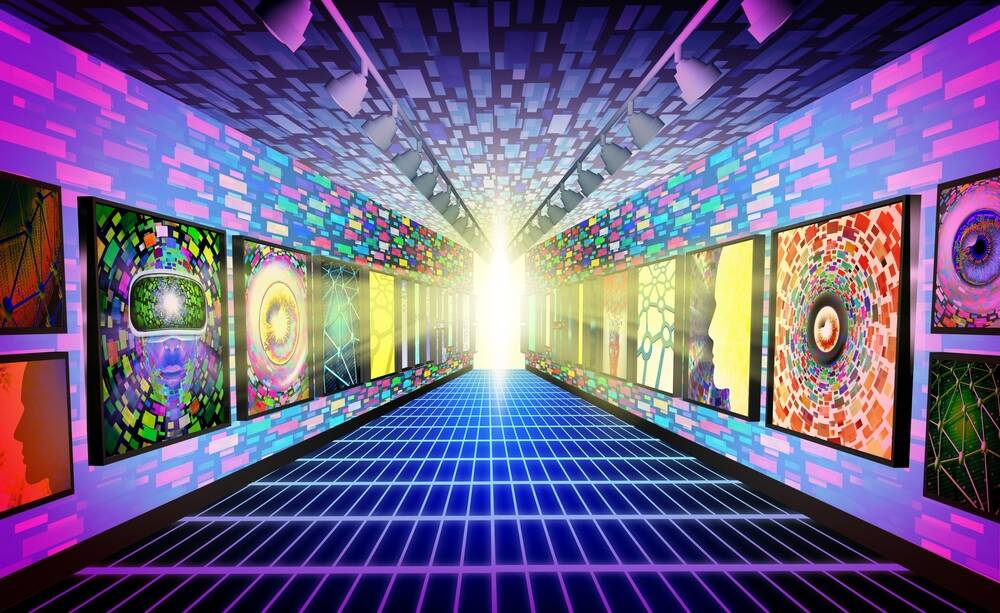Art
AI-generated art can be copyrighted, say US officials – with a catch
|
|


The US Copyright Office will consider an AI-generated work copyrightable if a human can prove they themselves put a meaningful amount of creative effort into the final content, according to a policy published on Thursday.
AI software capable of automatically generating images or text from an input prompt or instruction has made it easier for people to churn out content. Correspondingly, the USCO has received an increasing number of applications to register copyright protections for material, especially artwork, created using such tools.
US law states that intellectual property can be copyrighted only if it was the product of human creativity, and the USCO only acknowledges work authored by humans at present. Machines and generative AI algorithms, therefore, cannot be authors, and their outputs are not copyrightable.
Digital art, poems, and books generated using tools like DALL-E, Stable Diffusion, Midjourney, ChatGPT, or even the newly released GPT-4 will not be protected by copyright if they were created by humans using only a text description or prompt, USCO director Shira Perlmutter warned.
“If a work’s traditional elements of authorship were produced by a machine, the work lacks human authorship and the Office will not register it,” she wrote in a document outlining copyright guidelines.
“For example, when an AI technology receives solely a prompt from a human and produces complex written, visual, or musical works in response, the ‘traditional elements of authorship’ are determined and executed by the technology – not the human user.
“Instead, these prompts function more like instructions to a commissioned artist – they identify what the prompter wishes to have depicted, but the machine determines how those instructions are implemented in its output.”
The USCO will consider content created using AI if a human author has crafted something beyond the machine’s direct output. A digital artwork that was formed from a prompt, and then edited further using Photoshop, for example, is more likely to be accepted by the office. The initial image created using AI would not be copyrightable, but the final product produced by the artist might be.
Thus it would appear the USCO is simply saying: yes, if you use an AI-powered application to help create something, you have a reasonable chance at applying for copyright, just as if you used non-AI software. If it’s purely machine-made from a prompt, you need to put some more human effort into it.
In a recent case, officials registered a copyright certificate for a graphic novel containing images created using Midjourney. The overall composition and words were protected by copyright since they were selected and arranged by a human, but the individual images themselves were not.
“In the case of works containing AI-generated material, the Office will consider whether the AI contributions are the result of ‘mechanical reproduction’ or instead of an author’s ‘own original mental conception, to which [the author] gave visible form’. The answer will depend on the circumstances, particularly how the AI tool operates and how it was used to create the final work. This is necessarily a case-by-case inquiry,” the USCO declared.
Perlmutter urged people applying for copyright protection for any material generated using AI to state clearly how the software was used to create the content, and show which parts of the work were created by humans. If they fail to disclose this information accurately, or try to hide the fact it was generated by AI, USCO will cancel their certificate of registration and their work may not be protected by copyright law. ®





Art
Couple transforms Interlake community into art hub, live music 'meeting place' – CBC.ca
A trio plays a cover of The Eagles hit Take it Easy as a dozen people settle in for an intimate open mic night inside Derrick McCandless and Dawn Mills’s cozy spot off highways 6 and 68 in Manitoba’s Interlake.
Strings of antique-style light bulbs cast a soft glow over the mandolin, banjo and dobro guitar that hang on a wall behind the band. An array of pottery shaped in-house by Mills dots the shelves behind the audience.
The Eriksdale Music & Custom Frame Shop is full of tchotchkes — like an Elvis Presley Boulevard street sign and vintage Orange Crush ad — that create the rustic country-living vibe the couple dreamt up before buying and transforming the vacant space over the past three years.
“I have met so many people in this community through them that I probably wouldn’t have … because of this hub,” says Mills’s cousin Dana-Jo Burdett.
Mills and McCandless are bringing people together in their rural community in more ways than one — though a return to Mills’s hometown wasn’t always in the cards.
The couple met in Winnipeg in 2011 while McCandless was playing a party at Mills’s cousin’s place. They had plans to settle in the Okanagan in McCandless’s home province of B.C. until he suffered a health scare. After that, they decided to head back to the Prairies.
WATCH | McCandless and Mills channel creative spirit into Eriksdale community:
Dawn Mills and Derrick McCandless host the RogerKimLee Music Festival in the Manitoba Interlake community of Eriksdale. They also turned a long-vacant space in town into a live music venue, instrument repair and sales store, and pottery and framing services shop.
It was the height of the pandemic in fall 2020 when the pair relocated to Eriksdale, about 130 km northwest of Winnipeg. They bought the old Big Al’s shop, once a local sharpening business that was sitting vacant.
“He was an icon in the community. He was a school teacher. He did a drama program here,” said Mills. “He brought a lot to the town.”
The building has become their own personal playground and live-in studio.
“It keeps evolving and we keep changing it and every room has to serve multi-function,” says Mills. “It’s a meeting place.”
While they love the quiet life of their community, they’re also a busy couple.
McCandless is a multi-instrumentalist with a former career in the Armed Forces that took him all over. Now, he’s a shop teacher in Ashern who sells and fixes instruments out of the music shop.
WATCH | McCandless plays an original song:
Derrick McCandless plays one of his original songs on acoustic guitar at the Eriksdale Music & Custom Frame Shop in March 2024.
Mills helped found Stoneware Gallery in 1978 — the longest running pottery collective in Canada. She offers professional framing services and sells pottery creations that she throws in-studio.
They put on open mic nights and host a summer concert series on a stage next door they built together themselves. They’re trying to start up a musicians memorial park in Eriksdale too.


One of their bigger labours of love is in honour of McCandless’s good friends Roger Leonard Young, David Kim Russell and Tony “Leon” — or Lee — Oreniuk. All died within months of each other in 2020-2021.
“That was a heart-wrenching year,” McCandless says.
They channeled their grief into something good for the community and started the RogerKimLee Music Festival.


Friends from Winnipeg and the Interlake helped them put on a weekend of “lovely music, lovely food, lovely companionship” as a sort of heart-felt send off, said Mills.
That weekend it poured rain. Festival-goers ended up in soggy dog piles on the floor of the music shop to dry out while Mills and McCandless cooked them sausages and eggs to warm up.
“It was just a great weekend,” says McCandless. “At the end of that, that Sunday, we just said that’s it, we got to do this.”


Mills says the homey community spirit on display during that inaugural year is what the couple has been trying to “encourage in people getting together” ever since.
The festival has grown to include a makers’ market, car show, kids activities, workshops, camping, beer gardens, good food and live music.
This summer, Manitoba acts The Solutions, Sweet Alibi and The JD Edwards Band are on the lineup Aug. 16-18.


Burdett has been a part of the growth, helping with branding, social media and marketing. McCandless and Mills’s habit of bringing people together has also rubbed off on Burdett.
“There’s more of my people out here than I thought, and I am very grateful for that,” says Burdett.
Their efforts to breathe new artistic life into Eriksdale caught the attention of their local MLA.
“The response from family and friend and community has been outstanding,” Derek Johnston (Interlake-Gimli) said during question period at the Manitoba Legislature in March.
“The RogerKimLee Music Festival believes music to be a powerful force for positive social change.”


Dolly Lindell, who has lived in Eriksdale for about three decades, said the couple is adding something valuable that wasn’t quite there before.
“There’s a lot of people that we didn’t even know had musical talent and aspirations and this has definitely helped bring it out,” Lindell says from the audience as McCandless, Dave Greene and Mark Chuchie wrap their rendition of Take it Easy.
McCandless, 61, said there was a time in his youth where he dreamed of a becoming a folk music star. Now his musical ambitions have changed. He’s focused on using that part of himself to bring people together.
“I think it’s that gift that I was given that that needs to be shared,” he says. “I don’t think I could live without sharing it.”
WATCH | Trio plays song at Eriksdale music shop:
Derrick McCandless, Dave Greene and Mark Chuchie play a cover of The Eagles hit Take it Easy at McCandless and Dawn Mills’s music shop in Eriksdale in March 2024.
Art
Meet artist J-Positive and the family behind his art store – CBC.ca


- 1 day ago
- News
- Duration 4:42
Joel Jamensky’s sunny disposition explains why the artist with Down syndrome uses the name ‘J-positive’ for his online art business, started with the help of his parents two years ago. “There’s a lot more going on in [Joel’s] art than may be at first glance – just like him,” said his dad, Mark.
Art
Made Right Here: Woodworking art – CTV News Kitchener
[unable to retrieve full-text content]
Made Right Here: Woodworking art CTV News Kitchener





Source link
-
Business24 hours ago
Honda to build electric vehicles and battery plant in Ontario, sources say – Global News
-



 Health21 hours ago
Health21 hours agoSee how chicken farmers are trying to stop the spread of bird flu – Fox 46 Charlotte
-



 Investment22 hours ago
Investment22 hours agoOwn a cottage or investment property? Here's how to navigate the new capital gains tax changes – The Globe and Mail
-



 Health24 hours ago
Health24 hours agoSimcoe-Muskoka health unit urges residents to get immunized
-



 Science19 hours ago
Science19 hours agoOsoyoos commuters invited to celebrate Earth Day with the Leg Day challenge – Oliver/Osoyoos News – Castanet.net
-
News20 hours ago
Freeland defends budget measures, as premiers push back on federal involvement – CBC News
-
News23 hours ago
‘A real letdown’: Disabled B.C. man reacts to federal disability benefit – Global News
-



 Politics19 hours ago
Politics19 hours agoHaberman on why David Pecker testifying is ‘fundamentally different’ – CNN









